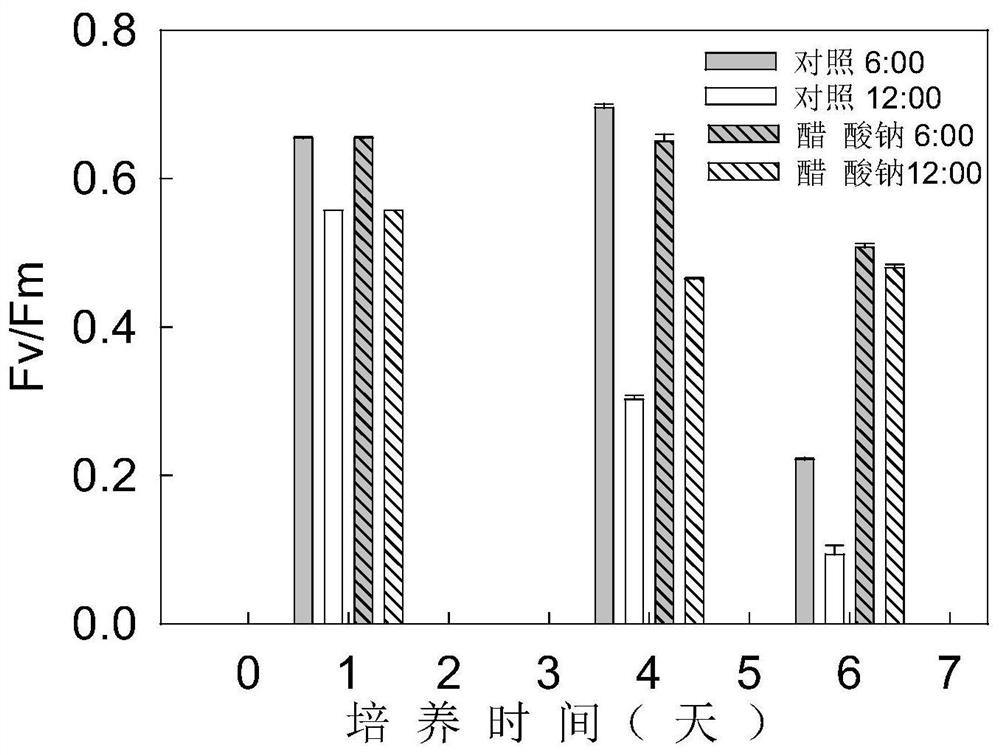A method for alleviating the photoinhibition of Haematococcus pluvialis
A technology of Haematococcus pluvialis and photoinhibition, applied in the direction of microorganism-based methods, methods using microorganisms, biochemical equipment and methods, etc., to achieve the effects of high cell density, low price, and various adding methods
- Summary
- Abstract
- Description
- Claims
- Application Information
AI Technical Summary
Problems solved by technology
Method used
Image
Examples
Embodiment 1
[0021] At a light intensity of 200μmol / m 2 Cultivate Haematococcus pluvialls cells under the condition of 14h / 10h light / dark ratio and reach the plateau stage, when the cell density is 502,400 cells / mL, dilute the Haematococcus pluvialls cells to 197,400 cells with tap water Cells / mL, add sodium acetate to a final concentration of 0.01mol / L, at a light intensity of 2800μmol / m 2 / s and the light-dark ratio of 14h / 10h induced the accumulation of astaxanthin. Such as figure 1 As shown, compared with the control group (no sodium acetate group), one-time addition of sodium acetate significantly reduced the degree of photoinhibition of Haematococcus pluvialis (the degree of decline in Fv / Fm).
Embodiment 2
[0023] At a light intensity of 200μmol / m 2 / s, light-dark ratio of 14h / 10h under the condition of culturing Haematococcus pluvialis cells reached the plateau stage, at this time the cell density was 513,600 cells / mL, and the Haematococcus pluvialls cells were diluted to 184,700 cells with tap water Cells / mL, add glycerol to a final concentration of 0.01mol / L, under a light intensity of 2000μmol / m 2 / s and the light-dark ratio of 14h / 10h induced the accumulation of astaxanthin. Such as figure 2 As shown, compared with the control group (without adding glycerol), the one-time addition of glycerin significantly reduced the degree of photoinhibition (decrease degree of Fv / Fm) of Haematococcus pluvialis.
Embodiment 3
[0025] At a light intensity of 160μmol / m 2 / s, light-dark ratio of 14h / 10h under the conditions of culturing Haematococcus pluvialis cells to reach the plateau stage, at this time the cell density is 497,100 cells / mL, dilute the Haematococcus pluvialls cells to 200,400 cells with tap water Cells / mL, add glycerol to a final concentration of 0.005mol / L, under a light intensity of 2500μmol / m 2 / s and the light-dark ratio of 14h / 10h induced the accumulation of astaxanthin. Such as image 3 As shown, compared with the control group (without adding glycerol), the one-time addition of glycerin significantly reduced the degree of photoinhibition (decrease degree of Fv / Fm) of Haematococcus pluvialis.
PUM
 Login to View More
Login to View More Abstract
Description
Claims
Application Information
 Login to View More
Login to View More - Generate Ideas
- Intellectual Property
- Life Sciences
- Materials
- Tech Scout
- Unparalleled Data Quality
- Higher Quality Content
- 60% Fewer Hallucinations
Browse by: Latest US Patents, China's latest patents, Technical Efficacy Thesaurus, Application Domain, Technology Topic, Popular Technical Reports.
© 2025 PatSnap. All rights reserved.Legal|Privacy policy|Modern Slavery Act Transparency Statement|Sitemap|About US| Contact US: help@patsnap.com



